Authentic Hungarian Goulash (Gulyás)
This post may contain affiliate links. See my disclosure policy.
A thoroughly authentic Hungarian Goulash recipe with a depth and richness of flavor that will satisfy both body and soul. Hungary’s national dish, this traditional gulyás captures everything that has made this dish so beloved across the globe. It is simply out-of-this-world delicious!
For more traditional Hungarian recipes be sure to also try my Chicken Paprikash, Bean Goulash, Pörkolt, and Szegedin Goulash!
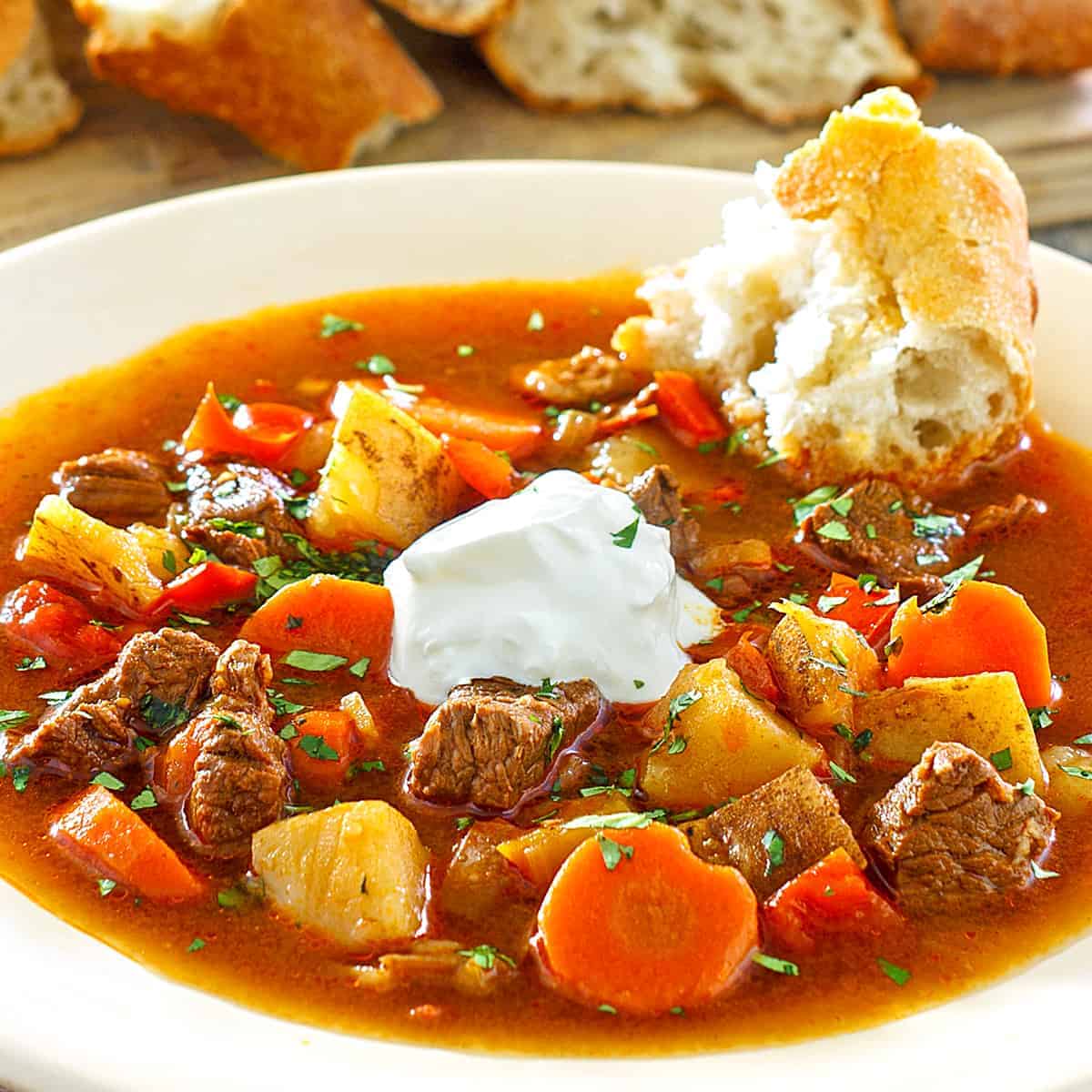
Traditional Hungarian goulash is a prime example of how a few simple ingredients, cooked properly, can yield an incredible flavor. Though many variations of Hungarian goulash exist, and every cook makes it just a bit differently, this is an authentic recipe from the heart of Hungary.
Hungary holds a special place in my heart and in my family’s hearts. My brother lived there for a couple of years and would always describe its beautiful scenery and architecture and his love for the Hungarian people. When I visited Budapest for the first time I immediately fell in love with it. Its name comes from the two sides of the city (Buda and Pest) separated by the Danube River running through it. With its striking chain bridge, stunning parliament building, and its incredible Buda Castle, Budapest is a breathtaking city.


Hungary’s history has been one of hardship and heartbreak. But the passion and stamina of soul has remained in the hearts of the Hungarian people. I’ve always been touched by Hungary’s national anthem, Himnusz, or “hymn”, written by the poet Kölcsey. Their anthem is a poetic prayer and unlike most anthems that focus on an expression of national pride, the Hungarian anthem is a direct, heartfelt plea to God. In the mid-20th century, during the years of strongest communist rule in Hungary, the words were not sung, only the music was played. The communist government asked two of the most acclaimed artists of that time, a poet and composer, to rewrite the national anthem. Both refused. The next communist leader also tried, unsuccessfully, to have it changed. And so Hungary’s national anthem remains Himnusz and its first three lines read:
O God, bless the nation of Hungary
With your grace and bounty
Extend over it your guarding arm

I also love Hungarian food. Their breads and smoked sausages are fantastic as are their meats, stews, sauces, and desserts. Today I’m going to share the national dish of Hungary: Goulash.
What is Hungarian Goulash?
Contrary to popular belief here in the U.S., Hungarian goulash is NOT made with ground beef or macaroni noodles! Traditional Hungarian goulash is an entirely different dish.
Goulash, or as Hungarians call it, gulyás, means “herdsman.” Its origins date back to the 9th century Magyar shepherds as a simple meat and onion stew prepared in heavy iron kettles known as bogracs. In the 15th century invading Ottoman Turks introduced a new spice to Hungary, paprika. While the rest of Europe remained lukewarm towards this red chili pepper from the New World, Hungary embraced it and paprika has since become a defining element of Hungarian cuisine.
Goulash is kind of in between a soup and a stew. Unlike some stews, Goulash is not overly packed full of beef and vegetables, it is a little more brothy. But through the cooking process, the broth becomes a little thicker and very rich in flavor.
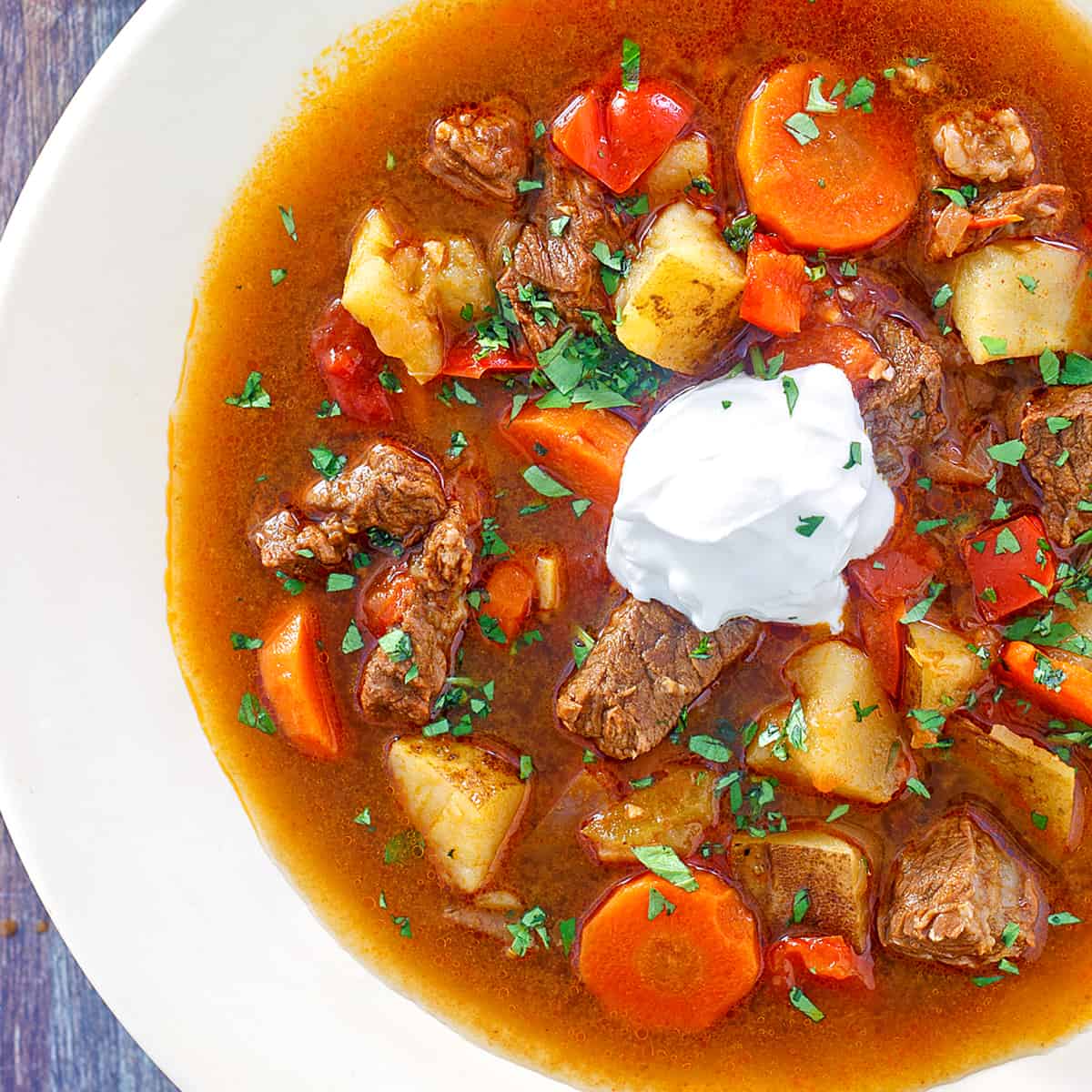
Tips for Authentic Hungarian Goulash
To achieve the ultimate flavor, the cooking method is important and quality, real Hungarian paprika is essential. And lots of it! None of this “2 teaspoons of paprika” jazz. Hungarians use very generous amounts of paprika, and that’s key. A Hungarian once told me, “however much paprika the recipe calls for – at least double or triple it!”
For this size batch of Goulash, you want to use a full 1/4 cup of it. When I lived in Germany, Hungary was just a few hours away and I would stock up on it when I visited. Now I order it online and recommend this genuine imported Hungarian paprika imported from Hungary. There is no comparison in flavor. It has an extraordinarily rich flavor and an exceptionally vibrant red color. Many of our readers have tried it and agree that quality Hungarian-imported paprika makes all the difference.
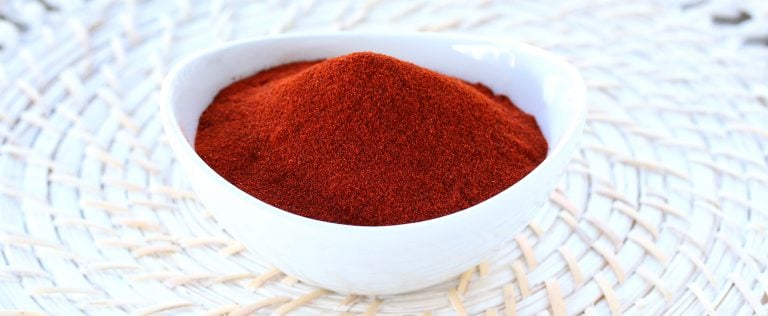
I mentioned earlier, many variations of goulash exist. Some include turnip or wine or caraway seeds, to name a few. But this recipe is a very old, very traditional way of making Goulash that my brother and I learned from older generations of Hungarian women and it needs no embellishments. It’s simple and simply delicious!
What’s the Best Dutch Oven to Use?
For this recipe, I recommend using a Dutch oven because it seals in the flavors and heats evenly, ensuring consistent cooking results. I love this 6-quart, budget-friendly option from Lodge, which you can get on Amazon for around $80. Or, if you’re looking for a worthy splurge, I also have this one from Le Creuset, which sells for around $300.
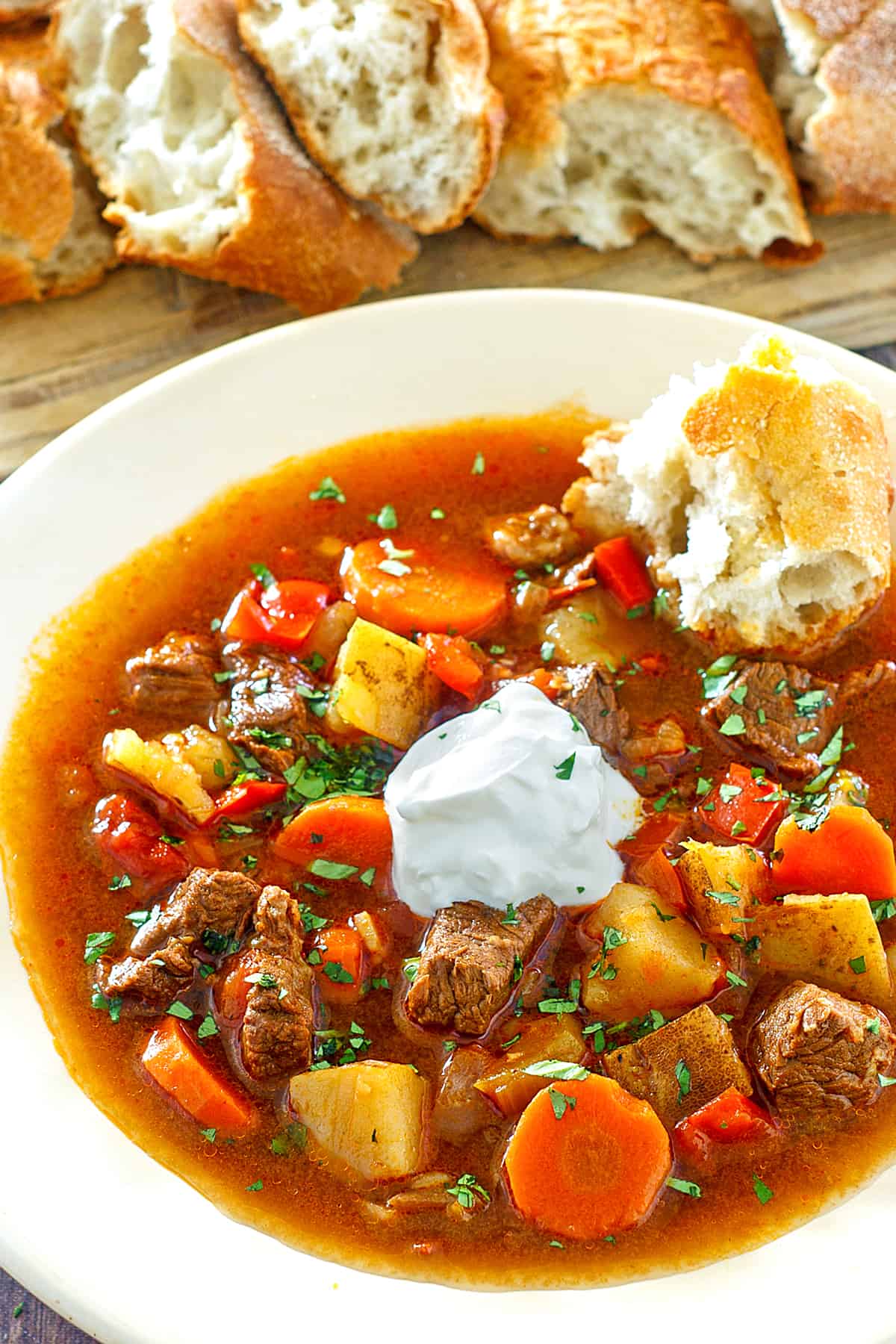
Hungarian Goulash Recipe
Let’s get started!
Melt the lard or butter/oil in a Dutch oven or other heavy soup pot over medium high heat and cook the onions until beginning to brown, about 7-10 minutes. Add the beef and cook until the beef is just starting to brown, 7-10 minutes.
Add the bell peppers, tomatoes, and garlic and cook for another 6-8 minutes. (Note about peppers: Outside of Hungary it’s very difficult to find the peppers they use there. The best ones to use in their place are red and some yellow/orange. Avoid regular green bell peppers as they have a starkly different flavor profile.)
Remove the pot from the heat and stir in the paprika, salt, pepper and caraway (if using) (note: paprika becomes bitter if at all scorched).
Add the beef broth, bay leaf, return to the stove and bring to a boil. Reduce the heat to medium, cover and simmer for 40 minutes. Add the carrots and potatoes. Return to a boil, reduce the heat to medium, cover, and simmer for another 30-40 minutes or until the beef is nice and tender. Add salt to taste. Remove the bay leaf.
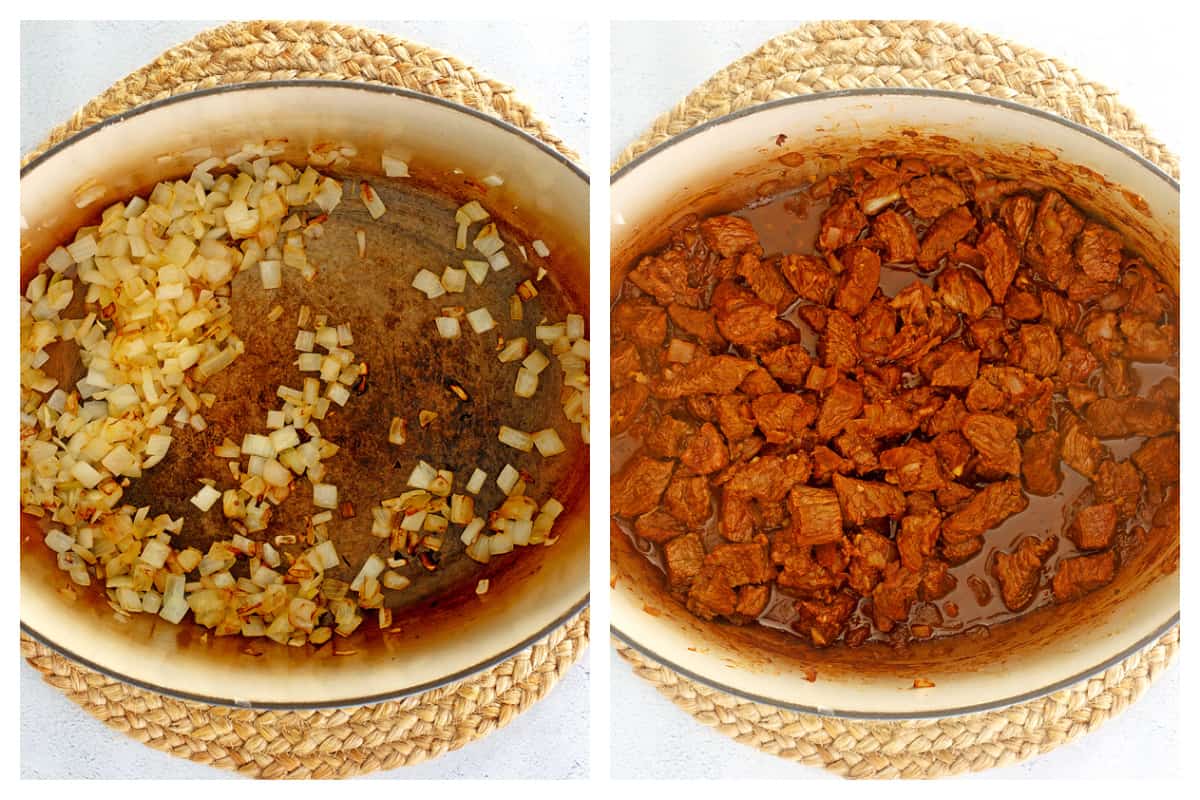
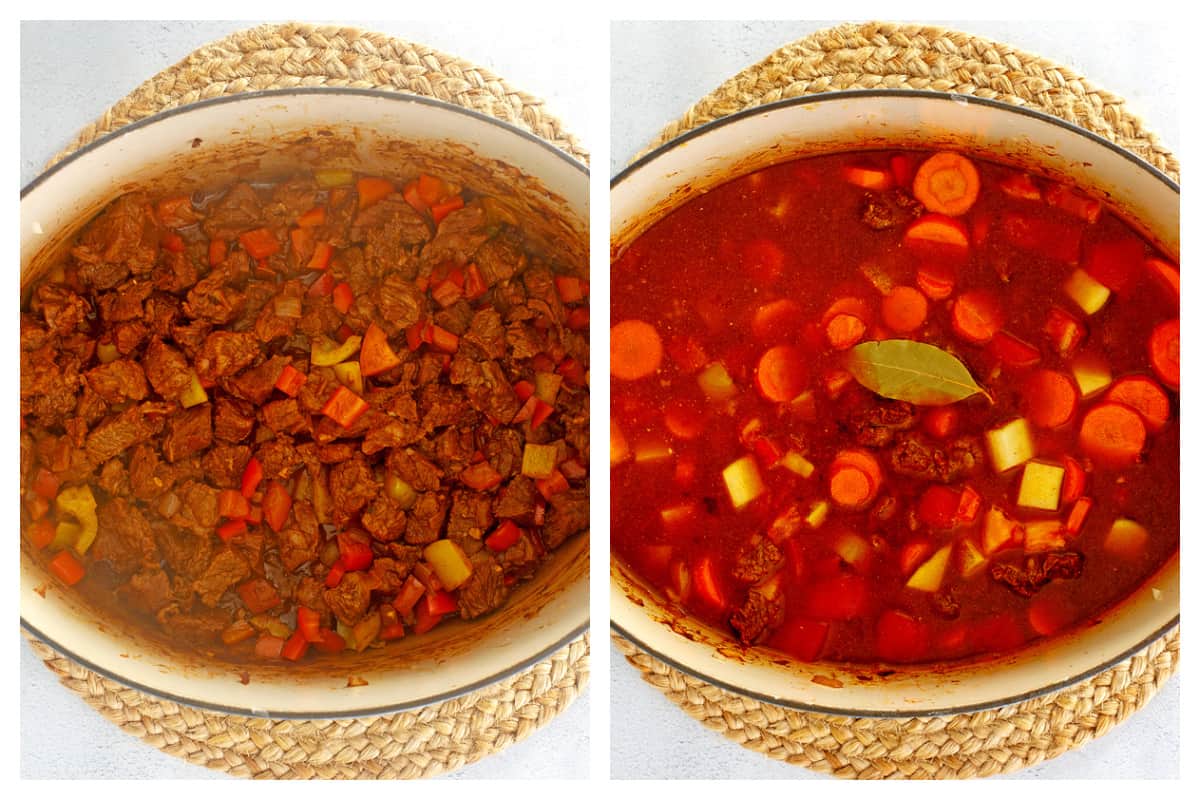
Serve with some crusty bread and, if desired, a dollop of sour cream.
Enjoy!
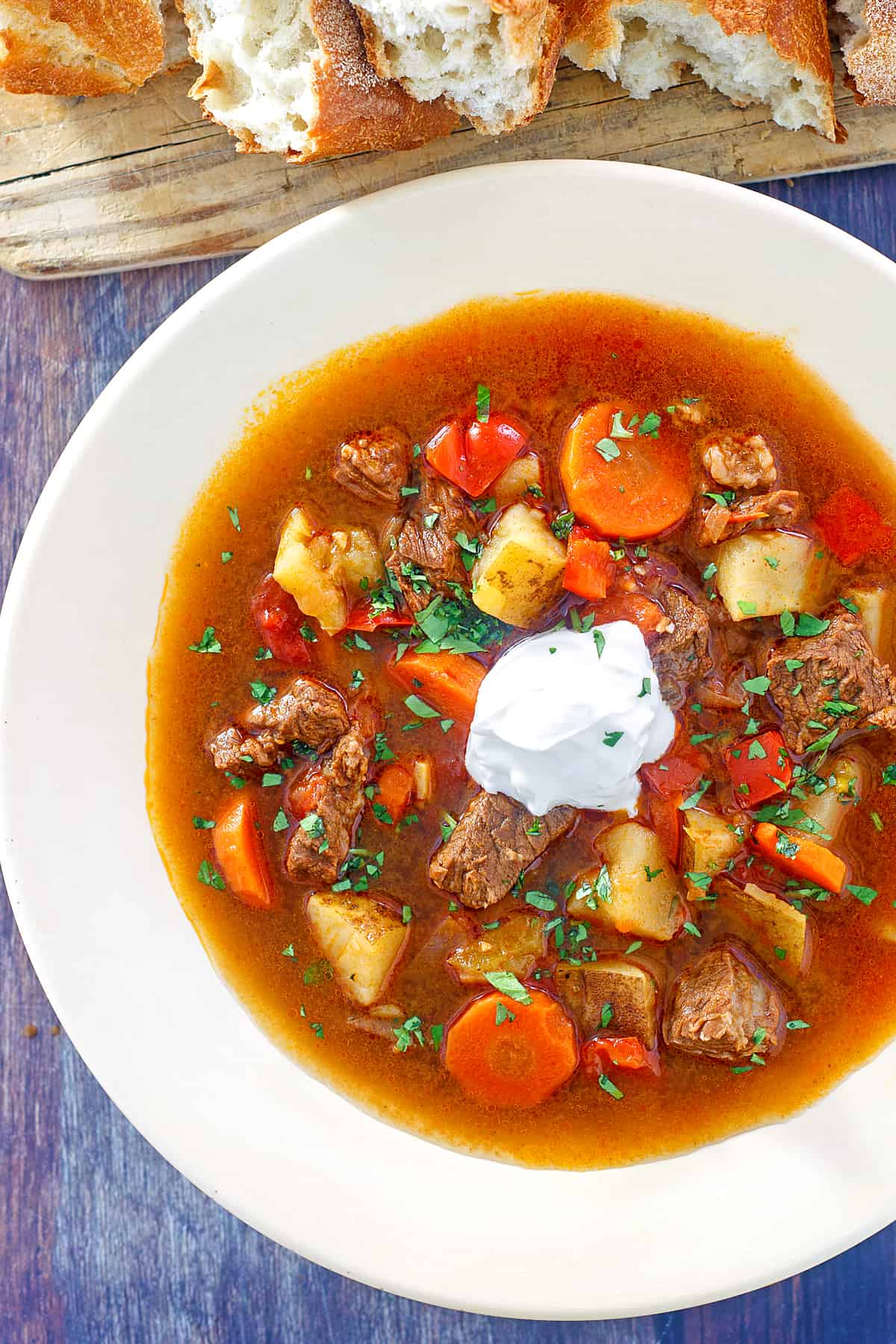
For more authentic Hungarian dishes, be sure to try my:
Save This Recipe
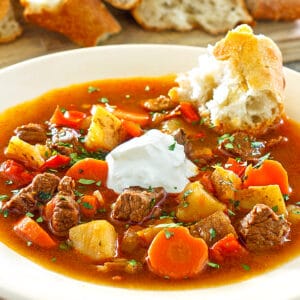
Authentic Hungarian Goulash (Gulyás)
Ingredients
- 3 tablespoons pork lard , or butter or bacon grease (pork lard is traditionally used and imparts a great flavor)
- 1 1/2 pounds yellow onions chopped
- 1/4 cup quality genuine imported Hungarian sweet paprika
- 1 1/2 pounds stewing beef , cut into 1/2 inch pieces
- 5 cloves garlic ,minced
- 2 red bell peppers ,seeded/membranes removed, cut into 1/2 inch chunks
- 1 yellow bell pepper ,seeded/membranes removed, cut into 1/2 inch chunks
- 2 tomatoes ,diced
- 2 carrots ,diced
- 2 medium potatoes ,cut into 1/2 inch chunks
- 5 cups beef broth (traditionally just water is used but beef broth adds so much more flavor)
- 1 bay leaf
- 1 teaspoon salt
- 1/2 teaspoon freshly ground black pepper
- 1/2 teaspoon crushed caraway seeds (optional, not traditional in all regions)
Instructions
- Melt the pork lard or butter/oil in a Dutch oven or other heavy soup pot over medium high heat and cook the onions until beginning to brown, about 7-10 minutes. Add the beef and cook until the beef is just starting to brown, 7-10 minutes. Add the bell peppers, tomatoes, and garlic and cook for another 6-8 minutes. Remove the pot from the heat and stir in the paprika, salt, pepper and caraway (if using) (note: paprika becomes bitter if at all scorched). Add the beef broth, bay leaf, return to the stove and bring to a boil. Reduce the heat to medium, cover and simmer for 40 minutes. Add the carrots and potatoes. Return to a boil, reduce the heat to medium, cover, and simmer for another 30-40 minutes or until the beef is nice and tender. Add salt to taste. Remove the bay leaf.
Nutrition
Originally published on The Daring Gourmet on March 18, 2014
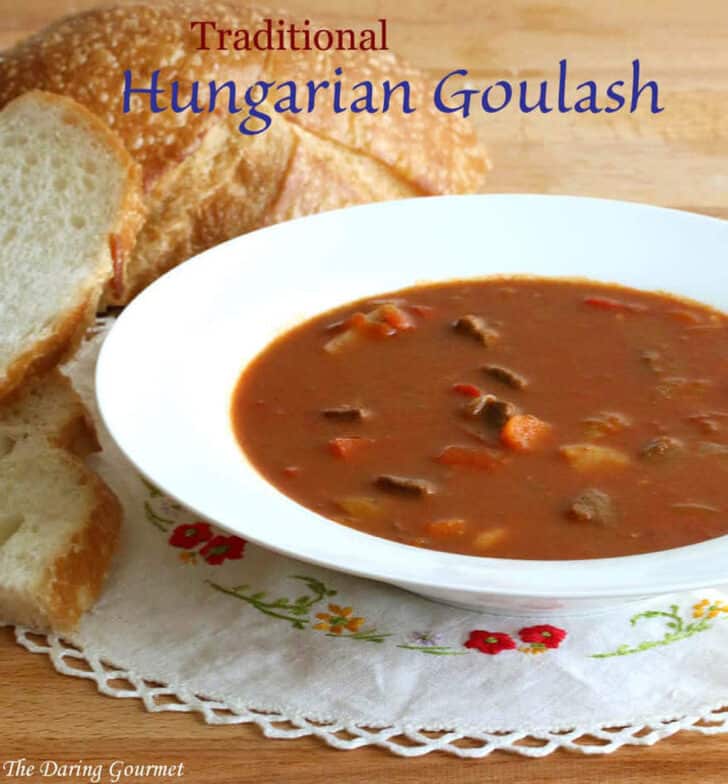



















We were in Hungary this summer and brought back some Paprika. Used your recipe today to try it out on some company over for lunch. It was spectacular and tasted just like the goulash we had in Hungary. Thanks for the great recipe!
That’s wonderful, Kate, I’m so happy to hear that and really appreciate the feedback, thank you!
Started prepping this dish for the umpteenth time now, only to find I’m out of paprika. What to do? Found some Kashmiri chilli powder and measure out a 1/4 cup and pop it in the pot. Some like it hot, heh. Turned out the goulash tastes spectacular. :)
Oh my gosh, Oliver, 1/4 cup Kashmiri chili powder!! You must have been blowing out fire ;) I’m glad it worked out for you in the end, thanks for the feedback!
Thanks so much, Kimberly, for your response to my inquiry. I have used juniper berries in sauerkraut and enjoyed the flavor, but I’m unfamiliar with lovage and savory. The flavor I am seeking is so distinctive in German and Czech cooking that I keep checking recipes to see what it may be. I’ll give savory and lovage a try. I’m so glad I found your website and will bookmark it so I can visit it frequently. Many thanks for your quick response!
You’re welcome, Linda! For herbs and seasonings, there really is nothing more “German” in flavor than savory, lovage, caraway and juniper. So if it isn’t one of those I’m not sure what it would be. If you discover what the flavor is you’re trying to identify, let us know. I’m glad you found my website too! If you haven’t already subscribed, that’s the best way to be notified via email of my latest recipe posts (I send out newsletters about once a week). You can subscribe HERE.
There is a particular spice/herb that I taste in German dishes (in Germany!) and also in ethnic restaurants in the Chicago area that gives a distinctive and wonderful flavor to dishes, from pork roast to Goulash Soup. I have no idea what it is and would give anything to know. I asked the woman who did the cooking in a Czech restaurant what the distinctive flavor was and she only said that she gets the flavoring from Switzerland. No help from her! It is not paprika or caraway. Do you have any suggestions?
Hi Linda, besides caraway the two other distinct flavors in German cooking are juniper berries and the herbs lovage (Liebstock in German) and savory (Bohnenkraut). Juniper berries are commonly used in things like Rotkohl, Sauerkraut and a variety of meat dishes and lovage and savory and used in a variety of stews, soups, salads, etc. Do any of those ring familiar?
Took me forever to wash, peel, and dice all the veggies, onions, garlic, and meat, but it was well worth it…As soon as it went from the pot to the bowl, couldn’t eat it slowly as it was so tasty, and was burning my tongue! Thanks for this authentic goulash recipe, it took me a while to find it as the internet kept popping up results for the elbow macaroni and ground beef “goulash”. My boyfriend and I both had a big bowl, with plenty of leftovers for another two or three meals. Definitely have some with sour cream, it is creamy and cold in contrast to the hot soup….next time we will remember to buy bread and have it with this!
Thanks for the feedback, D, so glad you enjoyed it!
So what cut of beef did you use?
I’ve used several different cuts of beef, whatever they’re having the best deal. See the note at the end of the recipe how to adjust the cooking process depending on what kind of cut you’re using.
We just returned from a river cruise on the Danube, starting in Budapest, where we had our first of many Goulash soups. I cannot wait to try your recipe!!! Thank you.
That sounds like a fabulous cruise, Phyllis. Happy cooking and let us know what you think!
The best from the best of all goulash recipes! Thank you!Cooked twice in Dubai after a trip to Budapest and all my friends are now begging me to do it again! :-) Big success! :-)
That’s terrific, Plamen, thank you!